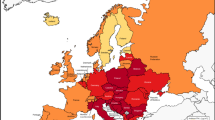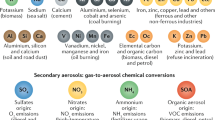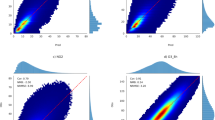Abstract
Health risks associated with short-term exposure to ambient air pollution are communicated to the public by the US EPA through the Air Quality Index (AQI), but it remains unclear whether the current regulatory-based, single-pollutant AQI fully represents the actual risks of air pollution-related illness. The objective of this study is to quantify cardiovascular hospital admissions attributable to PM2.5 at each AQI category. Based on National Ambient Air Quality Standards (NAAQS), the highest AQI value among criteria pollutants (driver pollutant) is reported daily. We investigated excess cardiovascular hospital admissions attributable to fine particulate matter (PM2.5) exposure from 2000 to 2010 in Bronx, Erie, Queens, and Suffolk counties of New York. Daily total, unscheduled cardiovascular hospital admissions (principal diagnosis) for individuals aged 20–99 years, concentration–response functions for PM2.5, and estimated quarterly effective daily concentrations were used to calculate excess cardiovascular hospital admissions when PM2.5 was reported as the driver pollutant and when PM2.5 was not reported as the driver pollutant at each AQI category. A higher proportion of excess hospital admissions attributable to PM2.5 occurred when PM2.5 was the driver pollutant (i.e., ~70% in Bronx County). The majority of excess hospital admissions (i.e., >90% in Bronx County) occurred when the AQI was <100 (“good” or “moderate” level of health concern) regardless of whether PM2.5 was the driver pollutant. During the warm season (April–September), greater excess admissions in Suffolk County occurred when PM2.5 was not the AQI driver pollutant. These results indicate that a single-pollutant index may inadequately communicate the adverse health risks associated with air pollution.
This is a preview of subscription content, access via your institution
Access options
Subscribe to this journal
Receive 6 print issues and online access
$259.00 per year
only $43.17 per issue
Buy this article
- Purchase on Springer Link
- Instant access to full article PDF
Prices may be subject to local taxes which are calculated during checkout




Similar content being viewed by others
References
Federal Register. Air Quality Index Reporting, Final Rule, 1999. 10/04/1999;64(149):42530.
Samet JM, Zeger SL, Dominici F, Curriero F, Coursac I, Dockery DW et al. The national morbidity, mortality, and air pollution study. Part II: morbidity and mortality from air pollution in the United States. Res Rep Health Eff Inst 2000; 94: 5–79.
Federal Register. National Ambient Air Quality Standards for Particulate Matter, Final Rule, 15 January 2013. 2013;78(10):3086..
Federal Register. National Ambient Air Quality Standards for Ozone, 27 March 2008. 2008;73(60):16436..
Federal Register. Primary National Ambient Air Quality Standards for Nitrogen Dioxide; Final Rule, 9 February 2010. 2010;75(26):6474..
Federal Register. Primary National Ambient Air Quality Standard for Sulfur Dioxide; Final Rule, 22 June 2010. 2010;75(19):35520..
Federal Register. Review of National Ambient Air Quality Standards for Carbon Monoxide; Final Rule, 31 August 2011, 2011;76(169):54294..
US EPA. Air Quality Index - A Guide to Air Quality and Your Health. 2014;EPA-456/F-14-002.
US EPA. Technical Assistance Document for the Reporting of Daily Air Quality – the Air Quality Index (AQI). 2013 December, 2013;EPA-454/B -13 - 001.
Revising the Air Quality Index and Setting a Significant Harm Level for PM2.5/OAQPS Issue Paper for Discussion at National Air Quality Conference; 12 February 2007; 2007.
Wen X, Balluz L, Mokdad A . Association between media alerts of air quality index and change of outdoor activity among adult asthma in six states, BRFSS, 2005. J Community Health 2009; 34: 40–46.
Neidell M . Information, avoidance behavior, and health: the effect of ozone on asthma hospitalizations. J Hum Resour 2009; 44: 450–478.
Neidell M, Kinney PL . Estimates of the association between ozone and asthma hospitalizations that account for behavioral responses to air quality information. Environ Sci Policy 2010; 13: 97–103.
Chen L, Villeneuve PJ, Rowe BH, Liu L, Stieb DM . The Air Quality Health Index as a predictor of emergency department visits for ischemic stroke in Edmonton, Canada. J Expos Sci Environ Epidemiol 2014; 24: 358–364.
To T, Shen S, Atenafu EG, Guan J, McLimont S, Stocks B et al. The air quality health index and asthma morbidity: a population-based study. Environ Health Perspect 2013; 121: 46–52.
Wong TW, Tam WWS, Yu ITS, Lau AKH, Pang SW, Wong AH . Developing a risk-based air quality health index. Atmos Environ 2012; 76: 52–58.
US EPA. AirData, 2014; available at http://www.epa.gov/airdata/index.html. Accessed 9 July 2014.
Toronto Public Health. Toronto Air Quality Index: Health Links Analysis. October 2001.
Moolgavkar SH . Air pollution and hospital admissions for diseases of the circulatory system in three US metropolitan areas. J Air Waste Manage Assoc 2000; 50: 1199–1206.
Zanobetti A, Franklin M, Koutrakis P, Schwartz J . Fine particulate air pollution and its components in association with cause-specific emergency admissions. Environ Health 2009; 8: 58.
R Core Team. R: A language and environment for statistical computing. Vienna, Austria, 2014. http://www.R-project.org.
Ontario Agency for Health Protection and Promotion (Public Health Ontario) Ontario Agency for Health Protection and Promotion (Public Health Ontario) Chen H Ontario Agency for Health Protection and Promotion (Public Health Ontario) Copes R . Review of air quality index and air quality health index. Toronto, ON: Queen's Printer for Ontario, 2013.
Stieb DM, Doiron MS, Blagden P, Burnett RT . Estimating the public health burden attributable to air pollution: an illustration using the development of an alternative air quality index. J Toxicol Environ Health A 2005; 68: 1275–1288.
Stieb DM, Burnett RT, Smith-Doiron M, Brion O, Shin HH, Economou V . A new multipollutant, no-threshold air quality health index based on short-term associations observed in daily time-series analyses. J Air Waste Manage Assoc 2008; 58: 435–450.
Chen R, Wang X, Meng X, Hua J, Zhou Z, Chen B et al. Communicating air pollution-related health risks to the public: an application of the Air Quality Health Index in Shanghai, China. Environ Int 2013; 51: 168–173.
Acknowledgements
We are grateful for the assistance of Melissa Payne. Funding for this study was provided in part by: (1) Air and Waste Management Association Mid-Atlantic States Section Air Pollution Education and Research Grant (APERG); and (2) NIH Training Grant, Grant Number T32 ES007324.
Author information
Authors and Affiliations
Corresponding author
Ethics declarations
Competing interests
The authors declare no conflict of interest.
Rights and permissions
About this article
Cite this article
Perlmutt, L., Stieb, D. & Cromar, K. Accuracy of quantification of risk using a single-pollutant Air Quality Index. J Expo Sci Environ Epidemiol 27, 24–32 (2017). https://doi.org/10.1038/jes.2015.43
Received:
Revised:
Accepted:
Published:
Issue Date:
DOI: https://doi.org/10.1038/jes.2015.43
Keywords
This article is cited by
-
A cross-sectional analysis of associations between environmental indices and asthma in U.S. counties from 2003 to 2012
Journal of Exposure Science & Environmental Epidemiology (2022)



